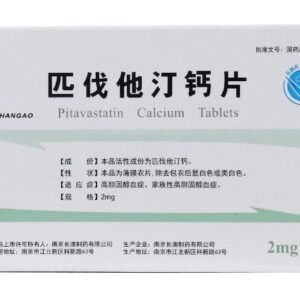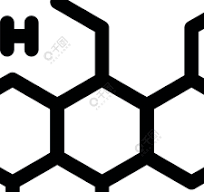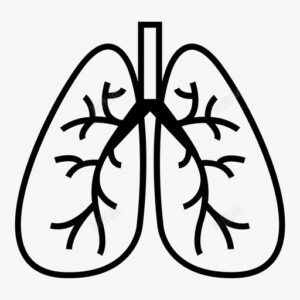Pitavastatin
Function and indication:
Pitavastatin calcium tablets/Pitavastatin calcium dispersible tablets: 1. This product is used for hypercholesterolemia and familial hypercholesterolemia. 2. Precautions: (1) A full examination must be carried out before use, and the use of this product should be considered only after confirming that the patient has hypercholesterolemia or familial hypercholesterolemia. (2) Since there is no experience in the use of homozygous familial hypercholesterolemia, this product is only considered as an adjuvant treatment for non-drug therapies such as partial clearance of LDL-blood components when it is determined to be necessary.
Dosage and administration:
The dosage and administration of this product may vary for different dosage forms and specifications. Please read the specific drug instructions for use or follow the doctor’s advice. Pitavastatin calcium tablets, pitavastatin calcium dispersible tablets: Generally, adults take 1-2 mg (i.e. 0.5-1 tablet) of this product orally once a day after dinner. The dose can be appropriately increased or decreased according to age and treatment response. If LDL-cholesterol is not sufficiently reduced, the dose can be increased. The maximum daily dose is 4 mg (i.e. 2 tablets). 1. When used for patients with liver disease, the initial dosage is 1 mg (i.e. 0.5 tablets) per day and the maximum dosage is 2 mg (i.e. 1 tablet) per day. (Refer to [Caution in Dosing, Pharmacokinetics]). 2. As the dosage (blood concentration) of this preparation increases, adverse events related to rhabdomyolysis may occur. Therefore, when the dosage is increased to 4 mg (i.e. 2 tablets), full attention should be paid to the early symptoms of rhabdomyolysis, such as increased creatine kinase (phosphocreatine kinase), myoglobinuria, muscle pain and weakness. In foreign clinical trials, the administration of more than 8 mg (i.e. 4 tablets) was terminated due to the occurrence of rhabdomyolysis and related adverse events. 3. When used for patients with moderate and severe renal insufficiency (glomerular filtration rate of 30-59 ml/min/1.73 m2 and 15-29 ml/min/1.73 m2, respectively, who do not receive hemodialysis) and end-stage renal disease who receive hemodialysis, the initial dosage is once a day, 1 mg each time, and the maximum dosage is once a day, 2 mg each time.
Adverse reactions:
In the clinical trials of pitavastatin calcium tablets/pitavastatin calcium dispersible tablets before their approval for marketing abroad (Japan), 197 out of 886 patients (22.2%) experienced adverse reactions. 50 cases (5.6%) experienced subjective (other) adverse reactions, with the main symptoms including abdominal pain, drug rash, fatigue, numbness, itching, etc. 167 cases (18.8%) had abnormal clinical examination values, mainly increased γ-GTP, increased CK (CPK), serum ALT (GPT), serum AST (GOT), etc. In the safety monitoring after marketing in Japan, 1210 out of 20002 cases (6.0%) experienced adverse reactions (5th safety periodic report). 1. Serious adverse reactions: (1) Rhabdomyolysis (incidence unknown): Rhabdomyolysis characterized by muscle pain, fatigue, increased CK (CPK), and increased myosin in blood and urine may occur. Accompanying the occurrence of rhabdomyolysis, severe renal dysfunction such as acute renal failure may occur. In this case, the drug should be discontinued. (2) Myopathy (incidence unknown): Myopathy may occur, so if widespread muscle pain, muscle tenderness or significant CK (CPK) elevation occurs, the drug should be discontinued. (3) Liver dysfunction and jaundice: Liver dysfunction and jaundice accompanied by significant elevation of ALT (GPT) and AST (GOT) may occur, so liver function tests should be performed regularly. If abnormalities are found, the drug should be discontinued and appropriate treatment should be given. (4) Thrombocytopenia (incidence unknown): Thrombocytopenia may occur, so blood tests should be performed carefully. If abnormalities are found, the drug should be discontinued and appropriate treatment should be given. 2. Other adverse reactions (Japanese data). (1) Incidence 0.1%-2.0%: ① Allergic symptoms Note (1): Rash, itching. ② Digestive system: belching, nausea, stomach discomfort, diarrhea. ③ Liver injection (2): Increased AST (GOT), increased ALT (GPT), increased γ-GTP, increased AL-P, increased LDH. ④ Muscle injection (3): Increased CK (CPK), muscle pain, fatigue. ⑤ Psychoneural system: headache, heaviness, numbness, dizziness. ⑥ Blood: anemia. ⑦ Endocrine: decreased testosterone. ⑧ Others: fatigue, positive antinuclear antibodies. (2) Incidence rate less than 0.1%: ① Allergy injection (1): urticaria. ② Digestive system: thirst, indigestion, abdominal pain, bloating, constipation, stomatitis, vomiting, loss of appetite, glossitis. ③ Liver injection (2): Increased bilirubin, increased cholinesterase. ④ Kidney: frequent urination, increased BUN, increased serum creatinine. ⑤ Muscle injection (3): muscle spasms. ⑥ Psychoneural system: stiffness, drowsiness, insomnia. ⑦ Blood: thrombocytopenia, granulocytopenia, leukocytopenia, eosinophilia, leukocytosis, increased globulin, positive serum antiglobulin test. ⑧ Endocrine: decreased aldosterone, increased aldosterone, increased ACTH, increased cortisol. ⑨ Others: palpitations, fatigue, skin pain, hot flashes, joint pain, edema, blurred vision, flickering vision, aural blockage, urinary occult blood, increased uric acid level, increased serum K, increased serum P, abnormal taste. (3) Unknown incidence: Allergic symptoms Note (1): Erythema. Note (1): Stop the drug at this time. Note (2): Observe fully and take appropriate measures such as stopping the drug if any abnormality occurs. Note (3): There is a possibility of early symptoms of rhabdomyolysis, so observe fully and stop the drug if necessary. The incidence is calculated based on the total of the Japanese approval and safety monitoring. 3. Post-marketing experience: There are rare reports of cognitive impairment in the post-marketing monitoring of statins abroad, which manifest as memory loss, memory decline, confusion, etc. Most of them are non-serious and reversible reactions, and they can generally recover after stopping the drug.
Contraindications:
Pitavastatin calcium tablets/pitavastatin calcium dispersible tablets: 1. The following patients are prohibited from taking this drug: (1) Patients with a history of allergy to the ingredients of this product. (2) Patients with severe liver disease or biliary tract obstruction (these patients may cause blood drug concentrations to increase when taking this drug
Share:
Products
Our offers
Health Classification
Let us work together to protect precious health






























